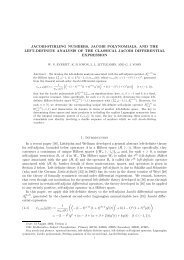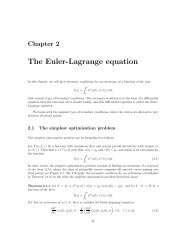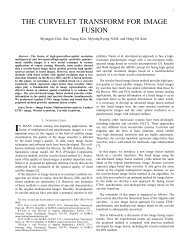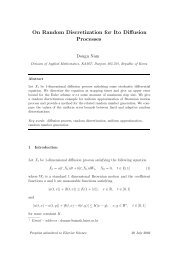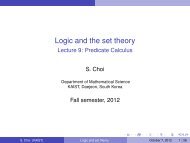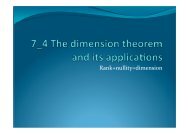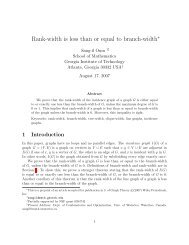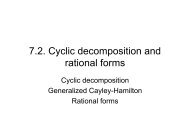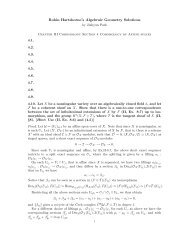Learning model structures based on marginal model structures of ...
Learning model structures based on marginal model structures of ...
Learning model structures based on marginal model structures of ...
Create successful ePaper yourself
Turn your PDF publications into a flip-book with our unique Google optimized e-Paper software.
x 2 x 3 x 1 x 4 P (X = x) x 2 x 3 x 1 x 4 P (X = x)0 0 0 0 1/42 1 0 0 0 3/421 2/42 1 1/421 0 2/42 1 0 6/421 4/42 1 2/421 0 0 2/42 1 0 0 6/421 4/42 1 2/421 0 1/42 1 0 3/421 2/42 1 1/42This distributi<strong>on</strong> satisfies the c<strong>on</strong>diti<strong>on</strong>al independencies displayed in graph (2b) in Figure 7.The <strong>marginal</strong> for X {1,3,4} satisfies the c<strong>on</strong>diti<strong>on</strong>al independence 1 ⊥4|3.Although we have seen examples where subgraphs <strong>of</strong> graphical log-linear <str<strong>on</strong>g>model</str<strong>on</strong>g>s are not Markovian,Markovian subgraphs are usual situati<strong>on</strong>s under the hierarchy assumpti<strong>on</strong> for <str<strong>on</strong>g>model</str<strong>on</strong>g>s. As indicatedin (7), in order for a subgraph to be n<strong>on</strong>-Markovian, a certain set <strong>of</strong> equati<strong>on</strong>s must be satisfiedbetween the set <strong>of</strong> parameters <strong>of</strong> a joint <str<strong>on</strong>g>model</str<strong>on</strong>g> and that <strong>of</strong> its interested n<strong>on</strong>-Markovian subgraph.This implies that n<strong>on</strong>-Markovian subgraphs are a rare situati<strong>on</strong> under the hierarchy assumpti<strong>on</strong> asl<strong>on</strong>g as interacti<strong>on</strong> graphs are c<strong>on</strong>cerned. Furthermore, when the distributi<strong>on</strong> is Normal, we can seeby its density functi<strong>on</strong> that the subgraphs are Markovian. Based <strong>on</strong> this point <strong>of</strong> view <strong>on</strong> Markoviansubgraphs, we have assumed in this paper that all the interacti<strong>on</strong> graphs <strong>of</strong> subsets V i <strong>of</strong> randomvariables are Markovian.The combinati<strong>on</strong> <strong>of</strong> <str<strong>on</strong>g>model</str<strong>on</strong>g> <str<strong>on</strong>g>structures</str<strong>on</strong>g> is in two steps, Uni<strong>on</strong> and Check <strong>of</strong> separateness. Supposewe combine the graphs in M. At the ‘Uni<strong>on</strong>’ step, we put an edge between every pair <strong>of</strong> nodesunless there exists at least <strong>on</strong>e graph in M where both <strong>of</strong> the nodes appear and are not adjacent; atthe ‘Check <strong>of</strong> separateness’ step, we then remove an edge when its existence is in c<strong>on</strong>flict with thenode-separateness in the graphs in M. In this process, we d<strong>on</strong>’t need data but the <str<strong>on</strong>g>model</str<strong>on</strong>g> <str<strong>on</strong>g>structures</str<strong>on</strong>g>.In this sense, the proposed method reuses the informati<strong>on</strong> that is embedded in the <strong>marginal</strong> <str<strong>on</strong>g>model</str<strong>on</strong>g><str<strong>on</strong>g>structures</str<strong>on</strong>g> for learning <str<strong>on</strong>g>structures</str<strong>on</strong>g> <strong>of</strong> a larger set <strong>of</strong> random variables which are involved in at least<strong>on</strong>e <strong>of</strong> the graphs in M.REFERENCESBalagtas, C.C., Becker, M.P. & Lang, J.B. (1995). Marginal <str<strong>on</strong>g>model</str<strong>on</strong>g>ling <strong>of</strong> categorical data fromcrossover experiments, Appl. Statist. 44, 63-77.Bartolucci, F. & Forcina, A. (2002). Extended RC associati<strong>on</strong> <str<strong>on</strong>g>model</str<strong>on</strong>g>s allowing for order restricti<strong>on</strong>sand <strong>marginal</strong> <str<strong>on</strong>g>model</str<strong>on</strong>g>ing, J. Am. Statist. Assoc. 97, 1192-9.Becker, M.P. (1994). Analysis <strong>of</strong> repeated categorical measurements using <str<strong>on</strong>g>model</str<strong>on</strong>g>s for <strong>marginal</strong>distributi<strong>on</strong>s: an applicati<strong>on</strong> to trends in attitudes <strong>on</strong> legalized aborti<strong>on</strong>. In SociologicalMethodology, Ed. P.V. Marsden, pp. 229-65. Oxford: Blackwell.Becker, M.P., Minick, S. & Yang, I. (1998). Specificati<strong>on</strong>s <strong>of</strong> <str<strong>on</strong>g>model</str<strong>on</strong>g>s for cross-classified counts:comparis<strong>on</strong>s <strong>of</strong> the log-linear <str<strong>on</strong>g>model</str<strong>on</strong>g> and <strong>marginal</strong> <str<strong>on</strong>g>model</str<strong>on</strong>g> perspectives, Sociological Methodsand Research 26, 511-29.15



